2013 Research Highlights
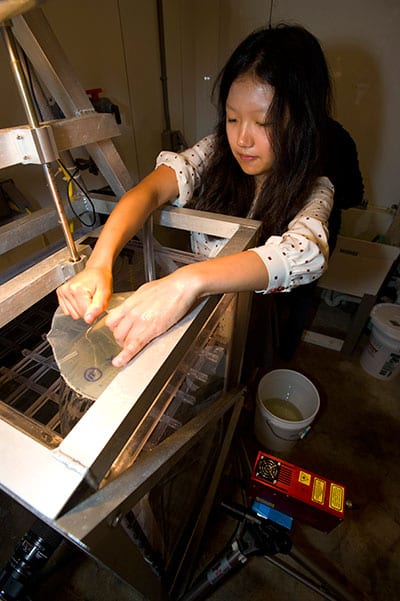
Quantifying oyster larvae swimming behaviour
Elaine Luo, University of Toronto
My summer student fellowship with Dr. Lauren Mullineaux and MIT-WHOI joint program student Jeanette Wheeler aims to quantify swimming and settlement behavior of oyster larvae (Crassostrea virginica). Oysters hold economic value to shellfisheries and recreational value for water clarification, but current wild populations have declined to 1% of historical numbers due to a combination of overharvesting and environmental perturbation. Potential effective population restoration strategies entail and understanding of the settlement behavior of oysters at the larval stage. Previous studies have shown mixed results on the effects of turbulence on individual larval settlement behaviour, and the effects of light on that response remains unclear. My project addresses two questions: i. what is the phototaxic response (swimming upwards towards light) of oyster larvae? ii. is this phototaxic behavior influenced by the addition of turbulence?
We acquire our oyster larvae from local hatcheries when they are competent to settle at the 200-300 micrometer range. Due to the difficulty in larval caretaking, our experiments usually consist of a continuous three-day stint of data collection to minimize mortalities. Larvae are placed in a grid-stirred turbulence tank, which has a drive rod connected to two grids that oscillate at various frequencies to produce different turbulence conditions. A high-speed camera, taking images at 60 frames per second, is focused on a field of view at the center of the tank. Since experiments are to be done both in the presence and absence of visible light, a powerful near-infrared laser, producing light that cannot be sensed by larval oysters, is used to illuminate the field of view.
Sequences of images are run through a program called Labview to identify larval tracks. Since the observed swimming velocities are composites of actual swimming behaviour and local flow, particle image velocimetry (PIV) is used to isolate swimming behaviour. In PIV, the water is seeded with many tiny, neutrally buoyant particles that are also illuminated by the laser in our field of view. Calculating the velocities of these passive particles in Matlab allows us to perform local flow subtraction on each larvae to isolate their swimming behaviour. Primarily, we are interested in looking at whether mean vertical velocities change with light to identify phototaxic (swimming upwards) or settlement behaviour (diving downwards), but we hope to extend our analyses other behaviours such as helical swimming as well.
Overall, my experience working with the Mullineaux lab for my Summer Student Fellowship has been incredible. Everything from the initial laser training, visiting hatcheries, peaceful gravenight shifts in the lab, completing my first Matlab script, to the enriching SSF events has been extremely beneficial to opening up the world of oceanography to me. I am grateful for this wonderful opportunity and am definitely hoping to return to WHOI for my graduate studies.
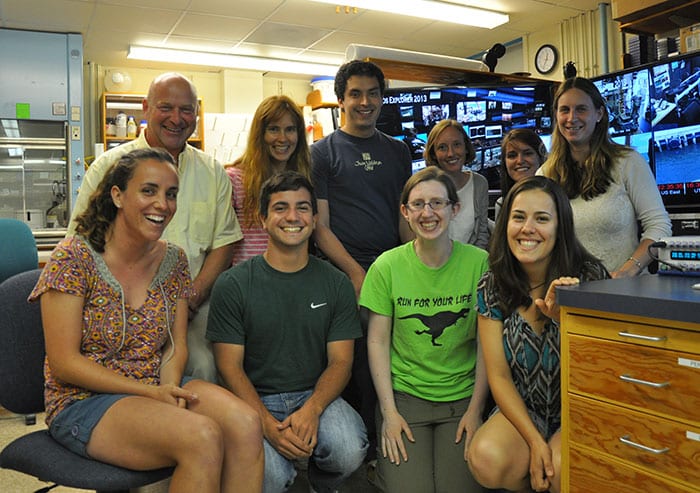
Dives into the Deep: Exploring Coral Ecosystems in Submarine Canyons
Kelly M. Williams, Allegheny College
Welcome to the bottom of the ocean! This is how I have taken to greeting the stream of visitors arriving in our lab recently to see the Remote Command Center (RCC) we have set up to participate in a research cruise. This is hands down the coolest thing (among many) I have had the opportunity to participate in so far this summer. The concept of a telepresence cruise like this one is to unite the public and scientists with different specialties from around the world to participate, through the wonders of the internet, in an exploration and research expedition, during which only two scientists are physically present on the ship.
My advisor, Dr. Timothy Shank, is the shore-based science lead for the ongoing exploration/research cruise being conducted by NOAA's vessel the Okeanos Explorer. This summer's focus is the biology and geology of the relatively unexplored submarine canyons off the coast of the northeastern US. It was news to me that we had a little-explored area in our own backyards, but we do, and interest in these canyons has surged recently due to the possibility of oil/gas exploration, fisheries management needs, and the desire to preserve vulnerable cold-water coral ecosystems. Most mornings for the past two weeks, I have been "on watch" in our RCC, following live streaming video of the dives, logging observations, and communicating with other scientists. This has been an empowering experience for an undergraduate like me. I was even able to travel to the Okeanos Explorer's home base, (the University of Rhode Island campus in Narragansett) to meet some of the other scientists and technicians involved in this project. To find out more about this cruise and see the live video feeds available to the public, follow this link.
My summer project is focused on these same canyons—specifically the coral ecosystems therein. I am looking at data (i.e. images) collected by a towed camera system in this region both this summer and in 2012. My goal is to map the distribution of several major coral groups (hard corals, soft corals, black corals, and sea pens) in these canyons and then search for differences in their distribution based on substrate type, depth, and canyon site. I will also complete the same analysis for a particular type of soft corals, the genus Anthomastus, in which we have already noted interesting patterns. While image analysis is slow going (2,000-3,000 photos per dive, and 20+ dives per cruise), the project is starting to take shape.
So why study coral distribution? I already mentioned the reasons for interest in these canyons, and corals are doubly important—not just in their own right, but also because they are habitat-forming fauna, hosting all manner of associate organisms. Yet we know relatively little about the specifics of their distribution in these canyons other than that it is "patchy" or very locally variable. Understanding coral distribution and the habitats they need is the first step in protecting them. It is absolutely fascinating and also an incredible opportunity. Though my project will barely scratch the surface of what there is to learn about coral ecosystems in Atlantic canyons (to say nothing of all of the other organisms therein), almost no matter what I discover, it will be significant. Very few undergraduates can say they have been involved in research that groundbreaking. Add that to all of the people I've met (scientists of all stripes and the many people who support their work), things I've done (ocean sampling on the R/V Tioga for instance), ideas I've gotten for my future (too numerous to list), and just the general all-around awesomeness of living on Cape Cod, and it's clear that I'm one lucky girl.
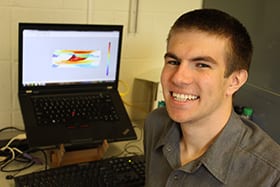
Balancing the Salinity Budget of the North Atlantic
Austen Blair, Humboldt State University
I started my SSF at WHOI by saying bon voyage to the recently refurbished Alvin as it left Woods Hole for its journey to California, my home state, for recertification. For my SSF project, I’m working with Dr. Ray Schmitt in the Physical Oceanography Department this summer. I’m studying the North Atlantic salinity maximum, which is a region of approximately 2-3 million square kilometers of very salty water (37 practical salinity units or higher). That’s a very loose definition of the area encompassed in this study, describing the very core of a larger high salinity region.
This area is salty due to evaporation removing fresh water from the ocean, leaving salts behind to concentrate. That much water entering the atmosphere plays a significant role in the global water cycle, which is why it is currently being studied by scientists like Ray and the Salinity Processes in the Upper Ocean Regional Study (SPURS) program at NASA-JPL. They hope to gain a better understanding of the oceanic role in the global water cycle, and studying salinity changes in the upper ocean is one of the best means of doing so.
My summer project addresses one aspect of these salinity changes called eddy diffusivity. This is the process by which salts from one body of water diffuse into an adjacent body of water due to turbulent mixing caused by eddies. This process can affect the salinity of a water mass without adding or removing water. Before using a change in salinity to determine how much water evaporated from a region, it is necessary to account for how other processes, like eddy diffusion, affected the salinity of the water. This diffusion rate is summed up in two separate coefficients that fit into the overall salinity balance equation.
To estimate these diffusivities for the North Atlantic salinity maximums, I’m using a data set of annually averaged salinity data spanning five decades. I run calculations on hundreds if not thousands of individual points in the North Atlantic Ocean using MATLAB®, and repeat the calculations over 33 depth layers. This will hopefully give a predictable average diffusivity to start basing future assumptions about the regional salinity changes on. I also made several different types of maps to visualize the region, which will prove helpful in identifying specific sites of interest for future research. Working on this project with Ray, being in the WHOI environment and experiencing the SSF enrichment programs has definitely cemented my passion for ocean research science and taught me so much more than I expected. I am very grateful for this opportunity to participate in the SSF program at WHOI.
As for my free time, the Cape is a great place to spend a summer. Summer Student Fellows are currently housed only a few minutes from a gorgeous beach looking out over Vineyard Sound. There are ponds with beautiful gardens bordering them nearby, the great little towns of Falmouth and Woods Hole to explore, and fantastic weather. I bike to work every day and get to enjoy marvelous views on the way. Hanging out with fellow ocean minded scientists has also been a fun and educational experience, and I’ve certainly made some lasting friends here. I still can’t believe that I got to spend a whole summer in such a beautiful place doing research I enjoy with such awesome scientists and new friends!
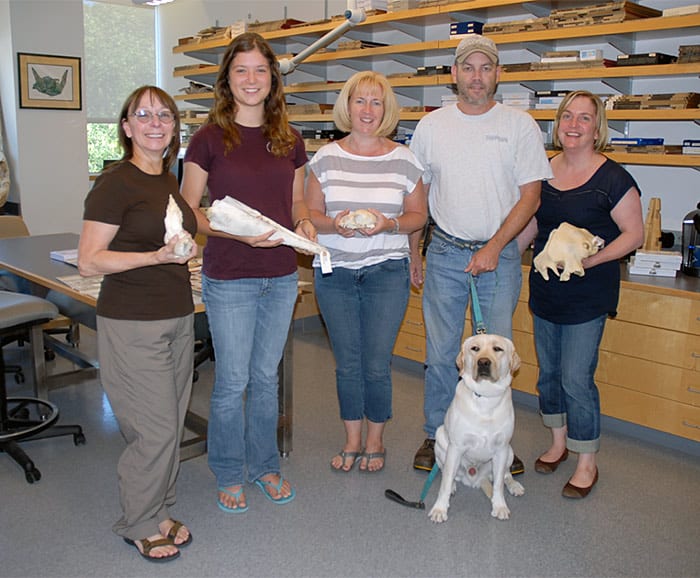
Close Calls between Bottlenose Dolphin (Tursiops truncatus) Mother-Calf and Male-Male Pairs in Sarasota Bay, Florida
Chantal Van Ginkel, Eckerd CollegeFrom performing detailed necropsies on dolphins and seals and observing CT scans of seals and small sharks, to learning about the anatomy and physiology of the marine mammal inner ear, my summer internship at the Woods Hole Oceanographic Institution was an incredible experience.
I spent my summer research working with Drs. Frants Jensen and Laela Sayigh on a project involving analyzing spectrograms of Tursiops truncatus (bottlenose dolphin) close calls between mother-calf and male-male pairs. Bottlenose dolphins depend on sound for communication, especially for maintaining contact between individuals. Mother-calf and male-male pairs are two types of long-term associations prevalent in wild bottlenose dolphin populations. Limited knowledge is available about how whistle source levels and vocalization rates may vary between such closely associated marine mammal pairings. The dolphins in this study were all from the Sarasota Bay area in Florida. Each animal was tagged with a DTAG, which is an acoustic tag that has two hydrophones and a radio antenna attached. DTAGs record depth and 3-D movement of the dolphin, as well as any vocalizations the individual produces, and ambient noise surrounding the dolphin. This recently developed method of collecting dolphin vocalization data is excellent in perceiving even the quietest calls that these dolphins make. I extracted the vocalizations from these recordings and analyzed dolphin pair whistles using customize software in MATLAB® and Adobe Audition.
Studying close calls furthers our understanding of dolphin communication and the potential ways in which anthropogenic noise pollution of marine environments may impact coastal bottlenose dolphins. Knowledge of the distances at which these animals can still remain in vocal contact and detect conspecifics is crucial for proper regulation and implementation of vessel traffic laws and other anthropogenic noise inputs into dolphin habitats. Since Sarasota Bay is such a high-noise-level environment, continued research concerning dolphin communication is important. Estimates and analyses of source levels with acoustic tags allow communication range to be measured.
Furthermore, the hands on experience of dissecting a risso’s dolphin and a grey seal, especially with experts Dr. Darlene Ketten (my summer advisor, who is a Senior Scientist in the WHOI Biology Department, and Associate Clinical Professor at Harvard Medical School in the Department of Otology and Laryngology)and Dr. Michael Moore (a Senior Research Specialist in the WHOI Biology Department) has been incredibly valuable as I deliberate what kind of PhD research I would like to pursue concerning marine mammal anatomy and/or physiology. Each necropsy yields valuable information to determine how the animal died. Often taking up to 6 hours, we always began the dissections by fully examining, measuring and sampling the exterior of the animal, before going through and taking samples of a wide variety of organs and tissues in each of the body cavities. Even taking samples of superficially normal-looking tissue might yield interesting abnormalities after histology is completed. Careful inspection of the mammal ear might indicate whether blast trauma from sonar was linked with the animal’s stranding. On the other hand, air bubbles in blood vessels could indicate that the animal was bycatch in some sort of large fishing net. CT scans also serve as extremely valuable insight into cause of death. The scans depicted detailed information such as deteriorated bone material, fractures, or bones that healed in a misaligned fashion.
This research experience at WHOI has helped me build a skill set in the field of marine mammal acoustics that I can apply to my senior thesis at Eckerd College this year. With everything I learned, and after meeting fantastic scientists and fellow summer student fellows, interning at WHOI was truly an amazing experience and I could not have asked for a better summer.
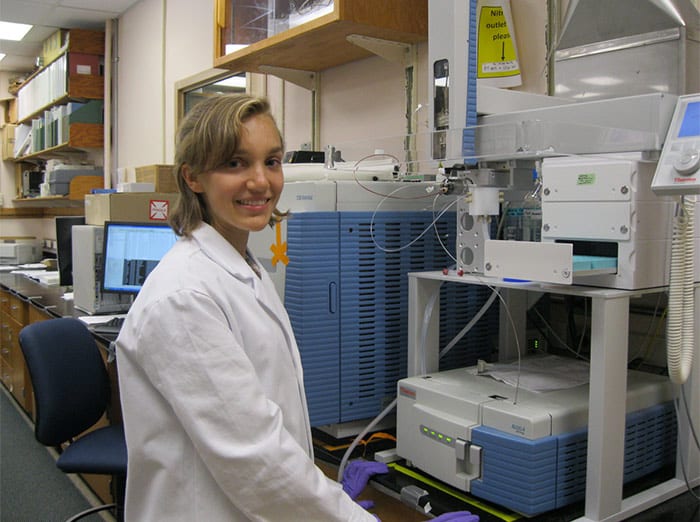
Metabolomics Study on Marine Microbes
Jacqueline Carozza
Cornell UniversityAs a chemistry major, I have always been interested in the molecules and reactions that lurk behind every biotic and abiotic process we know. When I came to WHOI to work with Elizabeth Kujawinski this summer, I had absolutely no previous experience with any environmental applications of chemistry. I found oceanography fascinating – WHOI chemists are working to trace large-scale ocean dynamics by understanding their molecular underpinnings, bridging a gap that spans orders of magnitude.
I hop on my bike in the morning and take the Shining Sea Bike Trail to my lab, where my project involves analyzing marine dissolved organic matter, or DOM. DOM is a massive pool of organic molecules that is produced and used primarily by marine microbes. Understanding the contours of microbial metabolism on a large scale could help us understand how carbon cycles in the ocean and atmosphere. This field of study is called metabolomics, and we hope to integrate the chemistry with the biology of marine microorganisms to get a better picture of ocean patterns.
In order to detect these highly variable compounds which are present in small quantities, we use high resolution mass spectrometry. The samples I am processing this summer came from a cruise off the coast of Canada. The microbes were filtered out of the seawater on the cruise, and then, in the lab, I take the cells caught on the filters and extract the chemical compounds present inside. The samples are introduced into the mass spectrometer, where the solvent is vaporized and carefully tuned voltages impart a charge on the molecules of interest. These charged particles enter the instrument, which can detect the molecules by measuring their masses to extremely high precision. After quantifying the amounts of compounds present in the samples, we can plot the data and use statistics to look for patterns, such as which metabolites are found at high concentrations, and which display gradients across a depth profile.
I have had the incredible opportunity to experience new chemistry research this summer. And even more than the interesting lab work – I was able to immerse myself in the science happening at WHOI. I caught a glimpse of what cruise work is like when I helped unload the R/V Knorr (the boat is huge and quite amazing!), which came into Woods Hole this summer after finishing up a cruise, and on the day cruise on the R/V Tioga. The seminars, the events, and, most importantly, the dedicated people who love their work and are more than willing to share it, have made this summer absolutely unforgettable.
